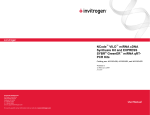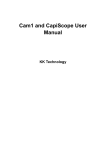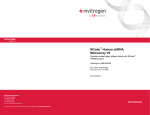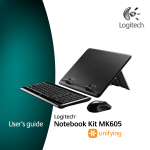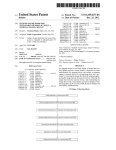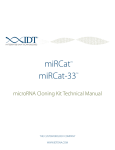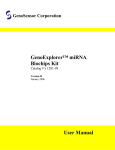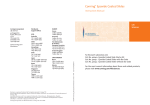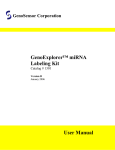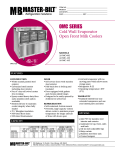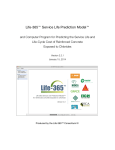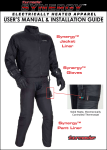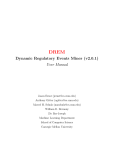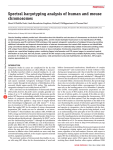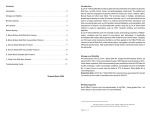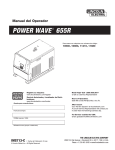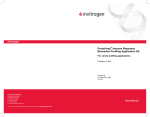Download NCode™ miRNA Labeling System
Transcript
NCode™ miRNA Labeling System For generating labeled microRNA molecules for hybridization to microarrays Catalog no. MIRLS-20 Version D 17 September 2007 25-0888 Corporate Headquarters Invitrogen Corporation 1600 Faraday Avenue Carlsbad, CA 92008 T: 1 760 603 7200 F: 1 760 602 6500 E: [email protected] For country-specific contact information visit our web site at www.invitrogen.com User Manual ii Table of Contents Kit Contents and Storage............................................................................................................................ v Related Products........................................................................................................................................ vii Overview .......................................................................................................................................................1 Methods........................................................................................................................................................ 6 Isolating Small RNA ....................................................................................................................................6 Quantifying Small RNA ..............................................................................................................................9 Polyadenylation of miRNA.......................................................................................................................10 Ligation of the Capture Sequence ............................................................................................................12 Purifying the Tagged miRNA...................................................................................................................13 Tagged miRNA Hybridization .................................................................................................................15 Array Wash .................................................................................................................................................18 Hybridization of Alexa Flour® Capture Reagents..................................................................................20 Final Array Wash .......................................................................................................................................23 Array Imaging and Analysis.....................................................................................................................25 Appendix .................................................................................................................................................... 26 Troubleshooting..........................................................................................................................................26 Purchaser Notification ...............................................................................................................................28 Technical Service ........................................................................................................................................29 References....................................................................................................................................................30 iii iv Kit Contents and Storage Shipping and Storage The NCode™ miRNA Labeling System is shipped in two modules. The Labeling Module is shipped on dry ice, while the Purification Module is shipped at room temperature. Store the components of the Labeling Module at –20°C, and the components of the Purification Module at room temperature. NCode™ miRNA Labeling Module Components should be stored at -20°C. Reagents are provided for 20 labeling and hybridization reactions. Item Amount 5X miRNA Reaction Buffer 25 mM MnCl2 10 mM ATP Poly A Polymerase DEPC-treated water T4 DNA Ligase (1 U/µl) 2X Hybridization Solution 6X Alexa Fluor® 3 Ligation Mix 6X Alexa Fluor® 5 Ligation Mix Alexa Fluor® 3 Capture Reagent* Alexa Fluor® 5 Capture Reagent* 100 µl 100 µl 20 µl 20 µl 2 ml 40 µl 2 × 1 ml 60 µl 60 µl 25 µl 25 µl Components should be stored at room temperature. NCode™ miRNA Purification Module Item Amount Low-Elution Volume Spin Cartridges (with collection tubes) 2 × 11 columns Binding Buffer (must be combined with 6.5 ml of 100% isopropanol 18 ml to create final buffer; see next page) 5 ml Wash Buffer (must be combined with 20 ml of 100% ethanol to create final buffer; see next page) Collection Tubes 22 tubes Continued on next page * Capture reagents contain 3DNA™ reagent manufactured under license from Genisphere, Inc. v Kit Contents and Storage, continued Preparing Binding Buffer with Isopropanol Each bottle of Binding Buffer must be mixed with 100% isopropanol prior to use. Add the amount of isopropanol indicated below directly to each bottle of Binding Buffer to create the final buffer. Be sure to mark the appropriate checkbox on the bottle to indicate that you have added the isopropanol. Binding Buffer 100% Isopropanol Final Volume Amount 18 ml (entire bottle) 6.5 ml 24.5 ml The Binding Buffer plus isopropanol is stable for at least six months at room temperature. Preparing Wash Buffer with Ethanol Each bottle of Wash Buffer must be mixed with 100% ethanol prior to use. Add the amount of ethanol indicated below directly to each bottle of Wash Buffer to create the final buffer. Be sure to mark the appropriate checkbox on the bottle to indicate that you have added the ethanol. Wash Buffer 100% Ethanol Final Volume Amount 5 ml (entire bottle) 20 ml 25 ml The Wash Buffer plus ethanol is stable for at least six months at room temperature. Product Qualification vi The Certificate of Analysis (CofA) provides detailed quality control information for this product. The CofA is available on our website at www.invitrogen.com/cofa, and is searchable by product lot number. Related Products The NCode™ miRNA Labeling System is part of an integrated microRNA expression profiling system that includes isolation, labeling, and array hybridization components. Additional products are available separately from Invitrogen. Ordering information is provided below. Additional Products For more information, visit our Web site at www.invitrogen.com or contact Technical Service (page 29). Product Quantity Catalog no. 25 preps K1570-01 20 reactions MIRAS-20 5 slides MIRA2-05 10 µl MIRAC2-01 3 × 384-well plates / 500 pmol per well MIRMPS2-01 200–2,000 cuvette assays R-11490 NCode SYBR Green miRNA qRT-PCR Kit 10 polyadenylation/ 20 cDNA synthesis/ 100 qPCR reactions MIRQ-100 NCode™ SYBR® GreenER™ miRNA qRT-PCR Kit 10 polyadenylation/ 20 cDNA synthesis/ 100 qPCR reactions MIRQER-100 NCode™ miRNA First-Strand cDNA Synthesis Kit 10 polyadenylation/ 20 cDNA synthesis 50 polyadenylation/ 100 cDNA synthesis MIRC-10 96-well plate (8 × 12 strip wells) R-32700 1 liter 4 liters 15557-044 15557-036 4 × 100 ml 1 liter 15553-027 24730-020 ™ PureLink miRNA Isolation Kit ™ NCode miRNA Amplification System NCode™ Multi-Species miRNA Microarray V2 NCode™ Multi-Species miRNA Microarray Control V2 NCode ™ Multi-Species miRNA Microarray Probe Set V2 Quant-iT™ Ribogreen® RNA Assay Kit ™ ® RediPlate™ 96 Ribogreen® RNA Quantitation Kit UltraPure™ 20X SSC UltraPure™ 10% SDS Solution MIRC-50 vii viii Overview Introduction The NCode™ miRNA Labeling System is a robust and efficient system for labeling enriched microRNAs (miRNAs) with fluorescent Alexa Fluor® dyes and hybridizing them to microarrays printed with species-specific antisense miRNA probes. The reagents in this kit have been optimized to ensure sensitive labeling from minimal RNA input, enabling simple and efficient profiling of miRNA expression patterns in various types of tissue, disease, and developmental states. System Overview First, you isolate small RNA using the PureLink™ miRNA Isolation Kit or your method of choice, and quantify. If necessary, amplify the enriched miRNA using the NCode™ miRNA Amplification System. Then use the NCode™ miRNA Labeling System to tag the miRNAs in a simple ~1-hour procedure and hybridize them to the microarray. Using the Labeling System, first you add a poly(A) tail to the miRNA using poly A polymerase and an optimized reaction buffer (this step if unnecessary if you are using amplified miRNA). Then you ligate a short, highly specific tag sequence to each tailed miRNA using a bridging oligo. Following a purification step, you hybridize the tagged miRNA to the microarray and incubate overnight. The next day, you wash the array, hybridize with Alexa Fluor® 3 and Alexa Fluor® 5 capture reagents, perform another wash, and scan using a standard microarray scanner. The capture reagents are comprised of DNA polymers, each with ~900 Alexa Fluor® molecules bound to a sequence complementary to the ligated tags on the hybridized miRNAs. The high specificity of the binding sequence and high fluorescence of the dye molecules ensure maximum signal-tobackground ratios and strong signal correlations. 5´ Experimental Outline 3´ miRNA Poly(A) tailing reaction 5´ 3´ Ligation of capture sequence to poly(A) tail Capture sequence Oligo(dT) bridge 5´ Day 1 (~1 Hour) 3´ Purification and hybridization of tagged miRNA to microarray Tagged miRNA miRNA probe Overnight Hybridization Wash and hybridization with Alexa Fluor® 3 / Alexa Fluor® 5 Capture Reagents Alexa Fluor® Capture Reagent Day 2 Tagged miRNA miRNA probe Continued on next page 1 Overview, continued MicroRNAs MicroRNAs (miRNAs) are a recently discovered class of small, ~19– 23-nucleotide non-coding RNA molecules. They are cleaved from hairpin precursors and are believed play an important role in translation regulation of target mRNAs by binding to partially complementary sites in the 3´ untranslated regions (UTRs) of the message (Lim, 2003). Several groups have hypothesized that there may be up to 20,000 non-coding RNAs that contribute to eukaryotic complexity (Bentwich et al., 2005; Imanishi et al., 2004; Okazaki et al., 2002). Though hundreds of miRNAs have been discovered, little is known about their cellular function. They have been implicated in regulation of developmental timing and pattern formation (Lagos-Quintana et al., 2001), restriction of differentiation potential (Nakahara & Carthew, 2004), regulation of insulin secretion (Stark et al., 2003), and genomic rearrangements (John et al., 2004). Several unique physical attributes of miRNAs—including their small size, lack of poly-adenylated tails, and tendency to bind their mRNA targets with imperfect sequence homology—have made them elusive and challenging to study. In addition, strong conservation between miRNA family members means that any detection technology must be able to distinguish between ~22-base sequences that differ by only 1–2 nucleotides. Recent advances in microarray and qPCR detection have enabled the use of these technologies for miRNA screening. Advantages of the System Alexa Fluor® Labeling Technology The NCode™ miRNA Labeling System provides the following advantages: • Requires less starting sample than comparable systems • Enriched miRNA samples can be tagged and hybridized in about an hour, followed by an overnight incubation • Optimized reagents and protocol ensure highly robust and reproducible reactions • Designed and developed as part of the comprehensive NCode™ system, which includes the NCode™ Multi-Species miRNA Microarray, Probe Sets, Amplification System, and Controls Alexa Fluor® 3 and Alexa Fluor® 5 Capture Reagents* contain branched DNA polymers ("dendrimers”), each with a core that consists of a matrix of doublestranded DNA, and an outer surface comprised of hundreds of singled-stranded “arms.” The surface arms carry ~900 Alexa Fluor® molecules, as well as highly specific sequences complementary to the ligated tags on the hybridized miRNAs. The high specificity of the binding sequences and high fluorescence of the Alexa Fluor® dye molecules ensure maximum signal-to-background ratios and strong signal correlations. *Capture reagents contain 3DNA™ reagent manufactured under license from Genisphere, Inc. Continued on next page 2 Overview, continued Other Products in the NCode™ System The NCode™ miRNA Labeling System was designed and developed in conjunction with the following products (for ordering information, see page vii): • The PureLink™ miRNA Isolation Kit is designed to purify small (≤200 nt) cellular RNA molecules, including regulatory RNA molecules such as miRNA and short interfering RNA (siRNA). The kit uses a silica-based twocolumn system to enrich small RNA from various sample sources, including cells, tissues, and total RNA. The enriched miRNA from this kit can be used directly in the NCode™ miRNA Labeling System. • The NCode™ miRNA Amplification System is a robust system for amplifying senseRNA molecules from minute quantities (<30 ng) of miRNA. The system provides consistent and accurate ≥1000-fold amplification while preserving the relative abundance of the miRNA sequences in the original sample, allowing you to compare relative quantities across experiments. The resulting amplified miRNA is in the sense orientation, for direct compatibility with NCode™ microarrays and probe sequences. • The NCode™ Multi-Species miRNA Microarray V2 consists of 5 Corning® Epoxide-Coated Glass Slides, each printed with optimized probe sequences targeting all of the known mature miRNAs in miRBase, Release 9.0 (http://microrna.sanger.ac.uk), for human, mouse, rat, D. melanogaster, C. elegans, and Zebrafish. The probes were designed using an algorithm that generates miRNA sequences with enhanced hybridization properties (Goff et al., 2005). Each slide comes blocked and ready to use. • The NCode™ Multi-Species miRNA Microarray Probe Set V2 includes the probe sequences provided on the NCode™ microarray, dried down in 384-well plates at 500 pmoles per well and ready for printing on standard DNA microarray surfaces. • The NCode™ Multi-Species miRNA Microarray Control V2 is a synthetic 22-nucleotide miRNA sequence that has been designed and screened as a positive control for use with NCode™ system. This control sequence has been tested for cross-reactivity with endogenous miRNAs from model organisms, and is provided at a concentration compatible with endogenous miRNA expression levels. • The NCode™ SYBR® Green miRNA qRT-PCR Kit provides qualified reagents for the detection and quantitation of miRNAs in quantitative RTPCR (qRT-PCR). This kit has been optimized for the detection and quantification of miRNA from 10 ng to 2.5 µg of total RNA using a SYBR® Green detection platform. • The NCode™ SYBR® GreenER™ miRNA qRT-PCR Kit provides qualified reagents for the detection and quantitation of miRNAs in real-time qRT-PCR. This kit has been optimized for the detection and quantification of miRNA from 10 ng to 2.5 µg of total RNA using a SYBR® GreenER™ detection platform. • The NCode™ miRNA First-Strand cDNA Synthesis Kit provides qualified reagents for the polyadenylation of miRNAs from total RNA and synthesis of first-strand cDNA from the tailed miRNAs for use in real-time quantitative PCR (qPCR). SYBR® Green or SYBR® GreenER™ reagents may be purchased separately. Continued on next page 3 Overview, continued NCode™ System Workflow Diagram Continued on next page 4 Overview, continued Materials Supplied The following materials are supplied by the user: by the User • 10 µg of total RNA or equivalent cells or tissue or amplified miRNA from the NCode™ miRNA Amplification System • Recommended: PureLink™ miRNA Isolation Kit (see page vii) • Recommended: Quant-iT™ Ribogreen® RNA Assay Kit or the RediPlate™ 96 Ribogreen® RNA Quantitation Kit (see page vii). • Recommended: NCode™ Multi-Species miRNA Microarray (see page vii) or NCode™ miRNA Microarray Probe Sets (see page vii) printed on epoxycoated glass slides (e.g., Corning® Epoxide-Coated Slides, catalog # 40041 or # 40044) • Recommended: NCode™ Multi-Species miRNA Microarray Controls (see page vii) • Hybridization chamber (e.g., Corning® Hybridization Chamber, catalog # 2551 or # 40080) • Raised-edge coverslips (for the NCode™ Microarray, we recommend LifterSlips™, Erie Scientific catalog # 25x60I-2-4789) • Lint-free laboratory wipes • Slide rack • 3 clean wash containers, capable of completely submerging an array slide in a slide rack (e.g., 400 ml). • Tabletop centrifuge with a microtiter plate rotor adapter capable of holding a slide rack, or with a slide holder • Digital microarray scanner (e.g., the GenePix® 4000B from Molecular Devices) and associated software • Incubators/water baths • Vortex mixer • SpeedVac® Concentrator (Savant Instruments, Inc.) or similar concentrator • Microcentrifuge • Aerosol resistant pipette tips • 1.5-ml RNase-free microcentrifuge tubes • 1 mM Tris, pH 8.0 • 0.5 M EDTA • 1X TE Buffer • 2X SSC/0.2% SDS (may be prepared from 20X SSC and 10% SDS, available from Invitrogen; see page vii) • 2X SSC • 0.2X SSC • 100% Isopropanol • 100% Ethanol 5 Methods Isolating Small RNA Introduction General Handling of RNA PureLink™ miRNA Isolation Kit In this step, you isolate small cellular RNA molecules from biological samples using a method of choice. • We recommend isolating and quantifying the small RNA in the morning and then labeling in the afternoon of the same day to avoid freeze-thawing and prolonged hybridization times. • Although the Poly(A) Tailing Procedure on page 11 includes instructions for adding NCode™ Multi-Species miRNA Microarray Controls to the tailing reaction, you can add 1 µl of diluted controls to each sample prior to isolation of small RNA, to verify your isolation procedure. See the documentation provided with the controls for details. When working with RNA: • • • • Use disposable, individually wrapped, sterile plasticware. Use aerosol resistant pipette tips for all procedures. Use only sterile, new pipette tips and microcentrifuge tubes. Wear latex gloves while handling reagents and RNA samples to prevent RNase contamination from the surface of the skin. • Use proper microbiological aseptic technique when working with RNA. • Dedicate a separate set of pipettes, buffers, and enzymes for RNA work. • Use RNase-free microcentrifuge tubes. If it is necessary to decontaminate untreated tubes, soak the tubes overnight in a 0.01% (v/v) aqueous solution of diethylpyrocarbonate (DEPC), rinse the tubes with sterile distilled water, and autoclave the tubes. You can use RNase Away™ Reagent, a non-toxic solution available from Invitrogen, to remove RNase contamination from surfaces. For further information on controlling RNase contamination, see (Ausubel et al., 1994; Sambrook et al., 1989). We recommend using the PureLink™ miRNA Isolation Kit (Invitrogen catalog no. K1570-01, see page vii) to isolate small cellular RNA molecules from biological samples. The NCode™ miRNA Labeling System was developed and optimized using enriched miRNA from the PureLink™ kit. The PureLink™ kit provides columns, reagents, and protocols for isolating small RNA molecules from a variety of cell and tissue types, in small and large sample volumes. We recommend isolating small RNA from 10 µg of total RNA, or equivalent cells or tissue. Continued on next page 6 Isolating Small RNA, continued Amount of Isolated Small RNA Required Typically, 10 µg of total RNA (or equivalent cells or tissue) yields 200–600 ng of small RNA molecules, depending on the sample. We recommend using this amount for each sample hybridized to the array. A dual-color hybridization would require two samples of 200–600 ng each. For smaller amounts of starting material, use the NCode™ miRNA Amplification System (see page vii). • When using the PureLink™ miRNA Isolation Kit to isolate small RNA, use the protocol below, which has been adapted from the standard PureLink™ protocol. Note that the following protocol uses 100% ethanol, which removes more debris from the sample, enhancing the performance of this kit. • We recommend starting with high-quality, isolated small RNA. We do not recommend using total RNA for amplification, labeling, and hybridization. Important Isolating Small RNA Using the PureLink™ miRNA Isolation Kit The following protocol has been adapted from the PureLink™ miRNA Isolation Kit manual, and may be used to isolate miRNA from up to 10 µg of total RNA. See the PureLink™ manual for protocols for isolating miRNA from cells or tissue. Materials needed: • Components of the PureLink™ miRNA Isolation Kit (Invitrogen catalog no. K1570-01, see page vii) • Total RNA sample • 70% ethanol • 96–100% ethanol • Microcentrifuge • RNase-free pipette tips Wash Buffer (W5): Prepare Wash Buffer (W5) for use by adding 40 ml of 96–100% ethanol to 10 ml of Wash Buffer (W5) included with the kit. Store the Wash Buffer (W5) with ethanol at room temperature. Procedure: 1. Resuspend total RNA in 300 µl of Binding Buffer (L3) supplied with the PureLink™ kit. Mix well by vortexing or pipetting up and down. 2. Add 300 µl of 70% ethanol to the solution. Mix well by vortexing. 3. Add the complete solution (600 µl) to a Spin Cartridge (preinserted in a Collection Tube) from the PureLink™ kit. 4. Centrifuge the Spin Cartridge at 12,000 × g for 1 minute at room temperature to collect the flow-through. Remove and discard the Spin Cartridge. Do not discard the flow-through. 5. Add 700 µl of 96–100% ethanol to the flow-through and vortex to mix. 6. Transfer 700 µl of the sample from Step 5 to a new Spin Cartridge in a Collection Tube. Procedure continued on next page Continued on next page 7 Isolating Small RNA, continued Isolating Small RNA Using the PureLink™ miRNA Isolation Kit, continued Procedure continued from previous page 7. Centrifuge the Spin Cartridge at 12,000 × g for 1 minute at room temperature. 8. Transfer the remaining sample from Step 5 to the Spin Cartridge from Step 6 and centrifuge at 12,000 × g for 1 minute at room temperature. 9. Discard the flow-through and re-insert the Spin Cartridge into the Collection Tube. 10. Add 500 µl of Wash Buffer (W5) prepared with ethanol (see above) to the Spin Cartridge. 11. Centrifuge 12,000 × g for 1 minute at room temperature. 12. Repeat Steps 10–11 one more time. 13. Discard the flow-through and place the Spin Cartridge into a Wash Tube supplied with the kit. 14. Centrifuge the Spin Cartridge at maximum speed for 2–3 minutes at room temperature to remove any residual Wash Buffer. Discard the Wash Tube. 15. Place the Spin Cartridge into a clean 1.7-ml Recovery Tube supplied with the kit. 16. Add 50–100 µl of sterile, RNase-free water (pH >7.0) supplied with the kit to the center of the Spin Cartridge (higher elution volumes may increase yield but will result in more dilute sample). 17. Incubate at room temperature for 1 minute. 18. Centrifuge the Spin Cartridge at maximum speed for 1 minute at room temperature. 19. The Recovery Tube contains purified small RNA molecules. Remove and discard the cartridge. Note: The recovery of the elution volume will vary and is usually 90% of the elution buffer volume used. Store the purified product at –80ºC, or proceed to quantification as described in the next section. 8 Quantifying Small RNA Introduction In this step, you determine the quantity of isolated small RNA prior to polyadenylation. This quantity is used to determine the amount of ATP to use in the polyadenylation procedure (see next page). Quantifying the Amount of Small RNA You must determine the quantity of isolated small RNA prior to poly(A) tailing. This quantity is used to determine the amount of ATP to use in the poly(A) tailing procedure (see next page). Isolated small RNA is typically too dilute to determine the quantity using A260 absorbance on a standard spectrophotometer. We recommend using the Quant-iT™ Ribogreen® RNA Assay Kit or the RediPlate™ 96 Ribogreen® RNA Quantitation Kit. Ordering information is provided on page vii. Each kit provides highly accurate fluorescent quantification of minute quantities of RNA, in the range of 1–1,000 ng/ml. A 1:20 dilution of RNA from the PureLink™ miRNA Isolation Kit should fall well within the linear range of the assay. The assay takes approximately 1 hour to complete. Alternatively, a capillary or other small-volume spectrophotometer may be used for quantitation. After quantifying the small RNA, we recommend that you proceed directly to Poly(A) Tailing of miRNA on page 10. The RNA may be stored at -80ºC, if necessary. Expected Yields with PureLink™ Kit Typical yields of small RNA molecules from various samples using the PureLink™ miRNA Isolation Kit are listed below. The quantities in the table were determined using the Quant-iT™ Ribogreen® RNA Assay Kit (see above). Material HeLa cells 293F cells Amount Yield 1 × 10 6 1.29 µg 1 × 10 6 1.95 µg Mouse liver 5 mg 710 ng Rat Spleen 5 mg 1.39 µg Spinach 60 mg 1.64 µg 1 × 10 6 6.21 µg 2 × 10 6 550 ng Yeast (S. cerevisiae) Bacteria (E. coli) 9 Polyadenylation of miRNA Introduction Important Before Starting After you have quantified the enriched miRNA, you are ready to add a poly(A) tail to the miRNA. If you are using amplified miRNA from the NCode™ miRNA Amplification System, it is already polyadenylated. Skip the following procedure and proceed directly to Ligation of the Capture Sequence on page 12. The following items are supplied in the NCode™ miRNA Labeling Module: • 5X miRNA Reaction Buffer • 25 mM MnCl2 • 10 mM ATP • Poly A Polymerase • DEPC-treated water The following items are supplied by the user: NCode™ MultiSpecies miRNA Microarray Controls • Enriched miRNA from 10 µg of total RNA (or equivalent cells or tissue) per sample • SpeedVac® Concentrator (Savant Instruments, Inc.) or similar instrument • Optional: NCode™ Multi-Species miRNA Microarray Controls (ordering information on page vii) • 1 mM Tris, pH 8.0 • Microcentrifuge • Incubator or water bath set at 37°C • 1.5-ml RNase-free microcentrifuge tubes NCode™ Multi-Species miRNA Microarray Controls are 10 unique 20–22nucleotide miRNA sequences that have been designed and screened as positive controls for use with NCode™ system. These control sequences have been tested for cross-reactivity with endogenous miRNAs from model organisms, and are provided at a concentration compatible with endogenous miRNA expression levels. NCode™ controls are provided at a concentration of 200 fmol/µl, and should be diluted 1:10 in DEPC-treated water and stored in single-use aliquots upon receipt, as described in the product insert provided with the controls. Add 1 µl of diluted control per sample, as described in the procedure on the next page. Continued on next page 10 Polyadenylation of miRNA, continued Polyadenylation Procedure Use the following procedure to add poly(A) tails to the enriched miRNA. Note: If you are using amplified miRNA from the NCode™ miRNA Amplification System, skip this procedure and proceed directly to Ligation of the Capture Sequence on page 12. 1. Following quantification of the enriched miRNA, concentrate the sample in a SpeedVac® Concentrator at low heat to a final volume of 14.5 µl. (Note: The elution volume from the PureLink™ miRNA Isolation Kit is 50–100 µl.) Optional: Add 1 µl of diluted NCode™ Multi-Species miRNA Microarray Controls to each tube of sample (see the product insert provided with the controls for the dilution procedure). Note that the concentration of the controls is so low that you do not need to factor it into the amount of enriched miRNA for the calculation in Step 3 below. Note: If you are not using the controls, add DEPC-treated water to each tube to a final volume of 15.5 µl. Based on the quantity of enriched miRNA, dilute a volume of 10 mM ATP in 1 mM Tris (pH 8.0) according to the following formula: ATP dilution factor = 5000/____ ng of enriched miRNA Example: If you are starting with 200 ng of miRNA, the ATP dilution factor is 5000/200 ng = 25. Dilute the ATP 1:25 by adding 1 µl of 10 mM ATP to 24 µl of 1 mM Tris, pH 8.0. 2. Add the following at room temperature to the tube of sample from Step 2: Component Tube from Step 2 5X miRNA Reaction Buffer 25 mM MnCl2 Diluted ATP (from Step 3, above) Poly A Polymerase Final Volume Volume 15.5 µl 5 µl 2.5 µl 1 µl 1 µl 25 µl 3. Mix gently and then centrifuge the tube briefly to collect the contents. 4. Incubate the tube at 37°C for 15 minutes. After incubation, proceed immediately to Ligation of the Capture Sequence, next page. 11 Ligation of the Capture Sequence Introduction In this step, you ligate the capture sequence to the poly(A)-tailed miRNA. Before Starting The following items are supplied in the NCode™ miRNA Labeling Module: • 6X Alexa Fluor® 3 Ligation Mix and 6X Alexa Fluor® 5 Ligation Mix • T4 DNA Ligase • DEPC-treated water The following items are supplied by the user: 6X Alexa Fluor® Ligation Mix • Polyadenylated miRNA (from the previous page, or polyadenylated amplified miRNA from the NCode™ miRNA Amplification System) • Microcentrifuge • 0.5 M EDTA • 1X TE Buffer Each 6X Alexa Fluor® Ligation Mix includes two oligonucleotides: • A 31-base oligonucleotide tag complementary to the capture sequence in the Alexa Fluor® Capture Reagent. • A 19-base bridging oligo, consisting of 9 bases complementary to the tag and 10 bases complementary to the poly(A) tail on each miRNA. miRNA sequence… AAAAAAAAAA 19-base Bridging Oligo Ligation Procedure 31-base Oligo Tag Use the following procedure to ligate the capture sequence to the tailed miRNA: 1. Briefly centrifuge each tube containing 25 µl of poly(A)-tailed miRNA from Poly(A) Tailing Procedure, Step 6, previous page. 2. Add the following components to each tube at room temperature. If you will be co-hybridizing two samples to the array, use Alexa Fluor® 3 Ligation Mix for one tube and Alexa Fluor® 5 Ligation Mix for the other. Component Tube from Step 1 Alexa Fluor® 3 Ligation Mix or Alexa Fluor® 5 Ligation Mix T4 DNA Ligase DEPC-Treated Water Final volume 3. Mix gently and then centrifuge the tube briefly to collect the contents. 4. Incubate at room temperature (20–28°C) for 30 minutes. 5. Stop the reaction by adding 4 µl of 0.5 M EDTA at room temperature. Briefly vortex and then centrifuge the tube. 6. Add 60 µl of 1X TE Buffer at room temperature for a final volume of 100 µl. Briefly vortex and then centrifuge the tube. Proceed to Purifying the Tagged miRNA, next page. 12 Volume 25 µl 6 µl 2 µl 3 µl 36 µl Purifying the Tagged miRNA Introduction Before Starting In this step, you purify the tagged miRNA. • If you are co-hybridizing two samples on the same array, the tagged miRNA from both samples may be loaded onto the same purification column. Be careful to load each sample separately as described below. Do not mix the samples before loading, to prevent cross-ligation. • During purification, you can begin thawing the 2X Hybridization Solution for the next procedure (see Step 1, Tagged miRNA Hybridization Procedure, page 16). The following items are supplied in the NCode™ miRNA Purification Module: • Low-Elution Volume Spin Cartridges (preinserted into collection tubes) • Collection Tubes • Binding Buffer (prepared with isopropanol as described on page vi) • Wash Buffer (prepared with ethanol as described on page vi) • DEPC-treated water The following items are supplied by the user: Purification Procedure • Microcentrifuge • Vortex mixer Use the following procedure to purify the tagged miRNA using the components of the Purification Module: 1. Add 700 µl Binding Buffer (prepared with isopropanol) to each tube of labeled miRNA from Ligation Procedure, Step 6, page 12. Mix thoroughly by vortexing, and centrifuge briefly to collect the contents. 2. Each Low-Elution Volume Spin Cartridge is preinserted into a collection tube. Load the entire volume of miRNA/Binding Buffer from a single tube directly onto the Spin Cartridge. If you have two samples for cohybridization, load only one sample at this time. 3. Centrifuge the Spin Cartridge at 3,300 × g in a microcentrifuge for 1 minute or until the entire volume passes through the cartridge. Remove the collection tube and discard the flow-through. 4. Optional: If you are co-hybridizing two samples, place the Spin Cartridge in the same collection tube and load the second sample on the cartridge. Then repeat Step 3. 5. Place the Spin Cartridge in the same collection tube and add 600 µl of Wash Buffer (prepared with ethanol as described on page vi) to the column. Procedure continued on the next page Continued on next page 13 Purifying the Tagged miRNA, continued Purification Procedure, continued Procedure continued from the previous page 6. Centrifuge at maximum speed for 30–60 seconds. Remove the collection tube and discard the flow-through. 7. Place the Spin Cartridge in the same collection tube and centrifuge at maximum speed for 60 seconds to remove any residual Wash Buffer. Remove the collection tube and discard. 8. Place the Spin Cartridge onto a new RNase-free 1.5-ml Collection Tube (supplied in the kit). 9. Add 20 µl of DEPC-treated water to the center of the Spin Cartridge and incubate at room temperature for 1 minute. 10. Centrifuge at maximum speed for 2 minutes to collect the purified tagged miRNA. The eluate contains your purified tagged miRNA. Proceed directly to Tagged miRNA Hybridization, next page. 14 Tagged miRNA Hybridization Introduction In this step, you hybridize the purified, tagged miRNA to an epoxy-coated glass slide printed with miRNA probes in the antisense orientation. NCode™ miRNA Microarrays and Probe Sets The hybridization reagents in this kit have been developed and optimized for use with epoxy-coated glass slides printed with NCode™ miRNA Microarray Probe Sets. Probe sets are available separately, or as part of the NCode™ Multi-Species miRNA Microarray (for ordering information, see page vii): Note on Hybridization Temperature • The NCode™ Multi-Species miRNA Microarray is a Corning® EpoxideCoated Glass Slide printed with approximately 900 unique probe sequences for miRNAs from six species (human, mouse, rat, D. melanogaster, C. elegans, and Zebrafish). Probes target all the miRNAs in Sanger mirBase 7.0 (http://microrna.sanger.ac.uk), as well as 144 predicted human miRNAs that have been designed using comparative regulatory motif analyses (Xie et al., 2005). Probes are printed in duplicate. Each NCode™ microarray comes blocked and ready to use, and is provided in a kit of five slides. See the user manual provided with the microarrays for more information, including download instructions for the array GAL file. • NCode™ miRNA Microarray Probe Sets are mammalian and nonmammalian probe sets in 384-well plates, dried down at 500 pmol per well. See the product insert provided with the probe sets for resuspension and printing guidelines. We have found that increasing the recommended hybridization temperature of 52ºC by a few degrees (to 54–56ºC) will increase hybridization specificity but reduce signal (sensitivity). We have found that 52ºC provides an optimal balance of sensitivity and specificity with the NCode™ Multi-Species miRNA Microarray. Make sure that the thermometer on your hybridization incubator is properly calibrated. The following procedure has been designed for use with epoxy-coated, glass slide microarrays. If you are using a different type of array, use hybridization solutions and protocols appropriate for that array. • NCode™ miRNA microarray products are designed for coverslip hybridizations with volumes of 80 µl or less. • Always wear powder-free latex gloves when handling microarrays and coverslips. Avoid contact with the printed array surface. The array surface should remain as lint-free and dust-free as possible. Open the slide container just prior to use, and close immediately to store unused slides. • The NCode™ Multi-Species miRNA Microarray is printed on the same side of the slide as the barcode. Important Continued on next page 15 Tagged miRNA Hybridization, continued Before Starting The following items are supplied in the NCode™ miRNA Labeling Module: • 2X Hybridization Solution • DEPC-treated water The following items are supplied by the user: • NCode™ Multi-Species miRNA Microarray (ordering information on page vii) or NCode™ miRNA Microarray Probe Sets (ordering information on page vii)printed on epoxy-coated glass slides (e.g., Corning® Epoxide-Coated Slides, with barcode, catalog # 40041, and without barcode, catalog # 40044) Tagged miRNA Hybridization Procedure • Hybridization chamber (e.g., Corning® Hybridization Chamber, catalog # 2551 or # 40080) • Lint-free laboratory wipes • Raised-edge coverslips (for the NCode™ Microarray, we recommend 25 × 60 LifterSlips™, Erie Scientific catalog # 25x60I-2-4789) • Incubator or water bath at 70ºC • Incubator or water bath at 75–80ºC • Incubator at 52ºC • Vortex mixer • Microcentrifuge Use the following procedure to hybridize the purified, tagged miRNA (from Purification Procedure, Step 10, page 14) to the NCode™ Multi-Species miRNA Microarray. This protocol may also be used with any epoxy-coated glass slide printed with miRNA probes: 1. Thaw the 2X Hybridization Solution by heating it at 70ºC for 10 minutes, and then vortexing to resuspend evenly. If necessary, repeat heating and vortexing until the buffer is fully resuspended. 2. The amount of Hybridization Mix per array depends on the coverslip size. Prepare as follows: Amount per Array Component 24 × 50 Coverslip 25 × 60 Coverslip Tagged miRNA (from Purification Procedure, Step 10, page 14) 20 µl 20 µl DEPC-treated water — 5 µl 25 µl 2X Hybridization Solution 20 µl Final Volume 40 µl 50 µl 3. Gently vortex and briefly centrifuge the Hybridization Mix, then incubate the mix at 75–80ºC for 10 minutes. Hold the mix at the hybridization temperature (52ºC) until loading the array. Protocol continued on next page Continued on next page 16 Tagged miRNA Hybridization, continued Tagged miRNA Hybridization Procedure, continued Protocol continued from previous page 4. Using powder-free latex gloves, inspect the coverslip to ensure it is clean. If necessary, gently wipe clean with a lint-free laboratory wipe. 5. Place the slide with the array facing up in an open, clean, dry hybridization chamber. The array on the NCode™ slide is printed on the same side as the barcode. The NCode™ microarray comes blocked and ready to use. 6. Gently vortex and briefly centrifuge the Hybridization Mix. Then: • For LifterSlips™ you may first place the slip on the array with the dull side of the white strips facing down along the length of the slide. Then position your pipette tip along an open (short) edge of the LifterSlip™, and slowly and carefully pipet the volume of prepared Hybridization Mix from Step 2 under the LifterSlip™, until the array surface underneath is completely covered with the mix. When pipetting, be careful not to form bubbles under the slip. If bubbles appear, you may try to remove them by gently tapping the LifterSlip™ with a pipette tip. • Alternatively, for either LifterSlips™ or non-raised-edge coverslips, pipet the volume of prepared Hybridization Mix down the center of the array and then carefully apply the coverslip. Be careful not to form bubbles under the slip. If bubbles appear, you may try to remove them by gently tapping the coverslip with a pipette tip. 7. Add the appropriate amount of DEPC-treated water or 2X Hybridization Solution to the hybridization chamber to maintain humidity, and seal the chamber. Maintaining controlled humidity during hybridization is crucial for successful microarray experiments to prevent the slide from drying out. 8. Place the hybridization chamber in an incubator at 52°C, and incubate overnight (16–20 hours). During incubation, you may prepare Wash Solution 1 and begin prewarming it to 50ºC (see Step 1, Array Wash Procedure, page 19). The next day, proceed to Array Wash, next page. 17 Array Wash Introduction Following overnight hybridization of the tagged miRNA, perform the array wash procedure in this section prior to hybridization of the Alexa Fluor® Capture Reagents. Before Starting The following items are supplied by the user: Prepare Wash Solutions • Wash Solution 1: 2X SSC/0.2% SDS (may be prepared from UltraPure™ 20X SSC and UltraPure™ 10% SDS Solution, available from Invitrogen; see page vii) • Wash Solution 2: 2X SSC • Wash Solution 3: 0.2X SSC • Clean slide rack • 3 clean wash containers, capable of completely submerging an array slide in a slide rack (e.g., 400 ml). • An additional wash container or squirt bottle for washing off the coverslip • Incubator or water bath at 50ºC • Vortex mixer • Tabletop centrifuge with a microtiter plate rotor adapter capable of holding a slide rack, or with a slide holder Prepare appropriate volumes of Wash Solution 1 (2X SSC/0.2% SDS), Wash Solution 2 (2X SSC), and Wash Solution 3 (0.2X SSC) prior to beginning the wash procedure. Prepare enough of each solution to fully submerge the slide in a slide rack in a wash container filled with the solution. The table below provides volumes for preparing 2 liters of each solution from UltraPure™ 20X SSC, UltraPure™ 10% SDS, and dH20: UltraPure™ 20X SSC UltraPure™ 10% SDS dH20 Wash Solution 1 200 ml 40 ml to 2 liters Wash Solution 2 200 ml — to 2 liters Wash Solution 3 20 ml — to 2 liters The following procedure has been designed for use with epoxy-coated, glass slide microarrays. If you have hybridized the tagged miRNA to a different type of microarray, use solutions and protocols appropriate for that array. Important Always wear powder-free latex gloves when handling arrays. Avoid contact with the printed array surface. The array surface should remain as lint-free and dust-free as possible. Continued on next page 18 Array Wash, continued Array Wash Procedure Follow the procedure below to wash the array slide hybridized with tagged miRNA from Tagged miRNA Hybridization Procedure, Step 8, page 17: 1. Prewarm the prepared volume of Wash Solution 1 (see previous page) to 50ºC. 2. Place a slide rack in a wash container, and fill the container with prewarmed Wash Solution 1 until the rack is completely submerged in the wash solution. 3. To wash the coverslip from the array slide, use one of two methods: • Fill another wash container with prewarmed Wash Solution 1. Remove the array slide from the hybridization chamber (Step 8, page 17) and, holding the slide at the barcode end, submerge it in Wash Solution 1. Gently move it back and forth in solution until the coverslip falls off. • Fill a squirt bottle with prewarmed Wash Solution 1. Remove the array slide from the hybridization chamber (Step 8, page 17) and, holding the slide at a downward angle, gently squirt the wash solution onto the surface until the coverslip falls off. 4. Quickly transfer the slide to the slide rack in prewarmed Wash Solution 1 from Step 2. Make sure the slide is completely submerged in the solution. Do not expose the slide to air for more than a few seconds to avoid air-drying. 5. Wash the array in Wash Solution 1 for 10–15 minutes at room temperature with gentle agitation (150–200 rpm). 6. Fill a clean wash container with Wash Solution 2 at room temperature. Transfer the slide rack with the slide to this wash container, and wash with gentle agitation at room temperature for 10–15 minutes. Do not expose the slide to air for more than a few seconds, and make sure that the slide is completely submerged in Wash Solution 2. 7. Fill a clean wash container with Wash Solution 3 at room temperature. Transfer the slide rack with the slide to this wash container, and wash with gentle agitation at room temperature for 10–15 minutes. Do not expose the slide to air for more than a few seconds, and make sure that the slide is completely submerged in Wash Solution 3. Important: Perform the next step quickly. To avoid high background on the array, do not allow the array surface to air dry prior to centrifugation. 8. Prepare a centrifuge with a microtiter plate rotor adapter that will accept the slide rack containing the array slide. (Balance the opposing arm of the rotor with a slide rack containing an equivalent number of empty slides.) Quickly transfer the slide rack with the slide to the centrifuge, and immediately spin for 2–4 minutes at 600 × g to dry. Do not centrifuge at higher speeds, or the slide might break. Proceed to Hybridization of Alexa Fluor® Capture Reagents, next page. 19 Hybridization of Alexa Flour® Capture Reagents Introduction Following the array wash, hybridize the Alexa Fluor® Capture Reagents to the tagged miRNA using the procedure in this section. The following procedure has been designed for use with epoxy-coated, glass slide microarrays. If you are using a different type of array, use hybridization solutions and protocols appropriate for that array. Before Starting The following items are supplied in the NCode™ miRNA Labeling Module: • Alexa Fluor® 3 Capture Reagent and Alexa Fluor® 5 Capture Reagent • 2X Hybridization Solution • DEPC-treated water The following items are supplied by the user: Alexa Fluor® 3 and Alexa Fluor® 5 Capture Reagents • Hybridization chamber (e.g., Corning® Hybridization Chamber, catalog # 2551 or # 40080) • Lint-free laboratory wipes • Raised-edge coverslips (e.g., LifterSlips™, Erie Scientific, catalog # 25x60I-24789) • Incubator or water bath at 50ºC • Incubator or water bath at 70ºC • Incubator or water bath at 75–80ºC • Incubator at 62ºC • Vortex mixer • Microcentrifuge Alexa Fluor® 3 and Alexa Fluor® 5 Capture Reagents* contain branched DNA polymers ("dendrimers”), each with a core that consists of a matrix of doublestranded DNA, and an outer surface comprised of hundreds of singled-stranded “arms.” The surface arms carry ~900 Alexa Fluor® molecules, as well as highly specific sequences complementary to the ligated tags on the hybridized miRNAs. Note that Alexa Fluor® 3 is identical to Alexa Fluor® 546, and Alexa Fluor® 5 is identical to Alexa Fluor® 647. Excitation and emission maxima are listed below: Alexa Fluor™ 3: Alexa Fluor™ 5: Excitation 556 nm 650 nm Emission 573 nm 665 nm *Capture reagents contain 3DNA™ reagent manufactured under license from Genisphere, Inc. Continued on next page 20 Hybridization of Alexa Flour® Capture Reagents, continued Important Preparing the Alexa Fluor® Capture Reagents Hybridization of Alexa Fluor® Capture Reagents Procedure • During the following procedure, minimize exposure of Alexa Fluor® Capture Reagents and the hybridized array to direct light, to avoid photobleaching. • Always wear powder-free latex gloves when handling arrays. Avoid contact with the printed array surface. The array surface should remain as lint-free and dust-free as possible. Before hybridization, prepare the Alexa Fluor® Capture Reagents as follows: 1. Thaw the Alexa Fluor® 3 and/or Alexa Fluor® 5 Capture Reagents in the dark at room temperature for 20 minutes. 2. Vortex the tube(s) at maximum speed for 3 seconds, then centrifuge briefly. 3. Incubate in the dark at 50–55ºC for 10 minutes. 4. Vortex the tube(s) at maximum speed for 3–4 seconds, and then centrifuge briefly to collect the contents. Follow the protocol below to hybridize the Alexa Fluor® Capture Reagents to the NCode™ Multi-Species miRNA Microarray. This protocol may also be used with any epoxy-coated glass slide printed with miRNA probes: 1. Thaw the 2X Hybridization Solution by heating it at 70ºC for 10 minutes, and then vortexing to resuspend evenly. If necessary, repeat heating and vortexing until the solution is fully resuspended. When resuspended, centrifuge for 1 minute. 2. Prepare the Hybridization Mix. Use Alexa Fluor® Capture Reagents thawed as described above. The amount of Hybridization Mix per array depends on the coverslip size. Note: The following table shows amounts for a dual-color hybridization. For single-color hybridizations, replace the volume of the second capture reagent with DEPC-treated water: Amount per Array Component 24 × 50 Coverslip 25 × 60 Coverslip Alexa Fluor® 3 Capture Reagent 2.5 µl 2.5 µl 2.5 µl 2.5 µl Alexa Fluor® 5 Capture Reagent DEPC-treated water 15 µl 20 µl 25 µl 2X Hybridization Solution 20 µl Final Volume 40 µl 50 µl 3. Gently vortex and briefly centrifuge the Hybridization Mix, then incubate in the dark at 75–80ºC for 10 minutes. After incubation, hold the mix at the hybridization temperature (62ºC) in the dark until loading the array. 4. Wearing powder-free latex gloves, inspect the coverslip to ensure it is clean. If necessary, gently wipe clean with a lint-free laboratory wipe. Procedure continued on next page Continued on next page 21 Hybridization of Alexa Flour® Capture Reagents, continued Hybridization of Alexa Fluor® Capture Reagents Procedure, continued Procedure continued from previous page 5. Place the washed array slide from Array Wash Procedure, Step 8, page 19, face-up in an open hybridization chamber. Important: When performing the following steps, to the extent possible shield the array from direct light, to avoid photobleaching of the capture reagents. 6. Gently vortex and briefly centrifuge the Hybridization Mix. Then either position a LifterSlip™ on the array and pipet the hybridization mix under the slip, or pipet the hybridization mix onto the array and then apply the coverslip, as previously described in Step 6, Tagged miRNA Hybridization, page 17. Once again, be careful to avoid the formation of bubbles under the coverslip. 7. Add the appropriate amount of DEPC-treated water or 2X Hybridization Solution to the hybridization chamber to maintain humidity, and seal the chamber. Maintaining controlled humidity during hybridization is crucial to prevent the slide from drying out. 8. Place the hybridization chamber in an incubator at 62°C for NCode™ arrays. Incubate in the dark for 4 hours. During incubation, you may prepare Wash Solution 1 and begin prewarming it to 60ºC (see Step 1, Final Array Wash Procedure, page 24). Proceed directly to Final Array Wash, next page. 22 Final Array Wash Introduction Following the 4-hour hybridization of the Alexa Fluor® Capture Reagents, perform the final array wash procedure as described in this section. Before Starting The following items are supplied by the user: Prepare Wash Solutions • Wash Solution 1: 2X SSC/0.2% SDS (may be prepared from UltraPure™ 20X SSC and UltraPure™ 10% SDS Solution, available from Invitrogen; see page vii) • Wash Solution 2: 2X SSC • Wash Solution 3: 0.2X SSC • Clean slide rack • 3 clean wash containers, capable of completely submerging an array slide in a slide rack (e.g., 400 ml). • An additional wash container or squirt bottle for washing off the coverslip • Incubator or water bath at 60ºC • Vortex mixer • Tabletop centrifuge with a microtiter plate rotor adapter capable of holding a slide rack, or with a slide holder Prepare appropriate volumes of Wash Solution 1 (2X SSC/0.2% SDS), Wash Solution 2 (2X SSC), and Wash Solution 3 (0.2X SSC) prior to beginning the wash procedure. Prepare enough of each solution to fully submerge the array slide in a slide rack in a wash container filled with the solution. The table below provides volumes for preparing 2 liters of each solution from UltraPure™ 20X SSC, UltraPure™ 10% SDS, and dH20: UltraPure™ 20X SSC UltraPure™ 10% SDS dH20 Wash Solution 1 200 ml 40 ml to 2 liters Wash Solution 2 200 ml — to 2 liters Wash Solution 3 20 ml — to 2 liters The following procedure has been designed for use with epoxy-coated, glass slide microarrays. If you have hybridized the tagged miRNA to a different type of microarray, use solutions and protocols appropriate for that array. Important • During this procedure, minimize exposure of the hybridized array to direct light, to avoid photobleaching. • Always wear powder-free latex gloves when handling arrays. Avoid contact with the printed array surface. The array surface should remain as lint-free and dust-free as possible. Continued on next page 23 Final Array Wash, continued Final Array Wash Procedure Follow the procedure below to wash the array slide from Hybridization of Alexa Fluor® Capture Reagents Procedure, Step 8, page 21. Be careful to minimize exposure of the hybridized array to direct light, to avoid photobleaching. 1. Prewarm the prepared volume of Wash Solution 1 (see previous page) to 60°C. 2. Place a slide rack in a wash container, and fill the container with prewarmed Wash Solution 1 until the rack is completely submerged in the wash solution. 3. To wash the coverslip from the array slide, use one of two methods: • Fill another wash container with prewarmed Wash Solution 1. Remove the array slide from the hybridization chamber (Step 8, page 17) and, holding the slide at the barcode end, submerge it in Wash Solution 1. Gently move it back and forth in solution until the coverslip falls off. • Fill a squirt bottle with prewarmed Wash Solution 1. Remove the array slide from the hybridization chamber (Step 8, page 17) and, holding the slide at a downward angle, gently squirt the wash solution onto the surface until the coverslip falls off. 4. Quickly transfer the slide to the slide rack in prewarmed Wash Solution 1 from Step 2. Make sure the slide is completely submerged in the solution. Do not expose the slide to air for more than a few seconds to avoid air-drying. 5. Wash the array in Wash Solution 1 for 10–15 minutes at room temperature with gentle agitation (150–200 rpm). 6. Fill a clean wash container with Wash Solution 2 at room temperature. Transfer the slide rack with the slide to this wash container, and wash with gentle agitation at room temperature for 10–15 minutes. Do not expose the slide to air for more than a few seconds, and make sure that the slide is completely submerged in Wash Solution 2. 7. Fill a clean wash container with Wash Solution 3 at room temperature. Transfer the slide rack with the slide to this wash container, and wash with gentle agitation at room temperature for 10–15 minutes. Do not expose the slide to air for more than a few seconds, and make sure that the slide is completely submerged in Wash Solution 3. Important: Perform the next step quickly. To avoid high background on the array, do not allow the array surface to air dry prior to centrifugation. 8. Prepare a centrifuge with a microtiter plate rotor adapter that will accept the slide rack containing the array slide. (Balance the opposing arm of the rotor with an slide rack containing an equivalent number of empty slides.) Quickly transfer the slide rack with the slide to the centrifuge, and immediately spin for 2–4 minutes at 600 × g to dry. Do not centrifuge at higher speeds, or the slide might break. Scan the array within ½ hour after the final wash step, to avoid photobleaching. See Array Imaging and Analysis, next page. 24 Array Imaging and Analysis Introduction Following the final wash step, arrays should be scanned immediately to minimize photobleaching of the Alexa Fluor® dyes. Scanning the Microarray • The array should be shielded from direct light and scanned within ½ hour of completion the final wash, to minimize photobleaching. • The NCode™ Multi-Species miRNA Microarray may be scanned using a standard digital microarray scanner. We recommend a scanner with a bit depth of at least 16 bits/pixel. The GenePix® 4000B (Molecular Devices) is a common microarray scanner, and includes software for analyzing the scanned image. • Alexa Fluor® 3 and 5 have excitation and emission maxima identical to Alexa Fluor® 546 and 647, respectively. Program your scanner accordingly. ™ Alexa Fluor 3: Alexa Fluor™ 5: Excitation 556 nm 650 nm Emission 573 nm 665 nm • Follow the instructions provided with your scanner for adjusting the photomultiplier tube (PMT) settings. It is important to adjust the PMT setting for each channel for maximum dynamic range and channel balance. • A typical lower limit of detection (LLD) is 8 times the median local background of all array features. The signal/background (S/B) ratio is calculated by dividing the median signal of positive features by the median background. • Be careful to position the slide in the proper orientation in the microarray scanner. If no signal is apparent after scanning, double-check the orientation of the slide. Consult your scanner documentation for details. When scanning dual-color arrays, we recommend examining the image histogram (available with GenePix® Pro software) to determine whether the signal intensities in the two channels are comparable. 25 Appendix Troubleshooting Problem Yield of enriched miRNA is low Cause Problems with the small RNA isolation procedure Degraded starting material Coverslip stuck to array surface Low or no overall fluorescent signal intensity on the array Hybridization chamber not properly sealed or humidified Solution ™ Use the PureLink miRNA Isolation Kit for optimal results. See your miRNA isolation kit manual for additional troubleshooting information. (Note that we do not recommend using total RNA in place of small RNA with this kit). Follow the guidelines on page 6 to prevent RNase contamination of the RNA preparation. Always use fresh samples or samples frozen at -80°C. If you are starting with total RNA, analyze it by agarose/ethidium bromide gel electrophoresis prior to isolation of small RNA. Make sure that the chamber is properly sealed with the correct amount of liquid prior to incubation Inadequate volume of Hybridization Mix used for coverslip size See the volumes specified in the Tagged miRNA Hybridization Procedure on page 16. Make sure that the Hybridization Mix completely covers the array surface under the LifterSlip™/coverslip. Photobleaching of the Alexa Fluor® Capture Reagents Avoid direct exposure of the Alexa Fluor® 3 and Alexa Fluor® 5 Capture Reagents and the hybridized array to light. Perform hybridization and wash procedures in low light conditions. Incubation temperatures during hybridization were incorrect Check the temperatures of all incubators with a calibrated thermometer. Degraded starting material Follow the guidelines on page 6 to prevent RNase contamination of the RNA preparation. Always use fresh samples or samples frozen at -80°C. If you are starting with total RNA, analyze it by agarose/ethidium bromide gel electrophoresis prior to isolation of small RNA. Insufficient blocking of the array prior to hybridization If you are printing your own arrays, carefully follow all array blocking procedures. NCode™ Multi-Species miRNA Microarrays come fully blocked and ready to use. Array slide scanned in wrong orientation Check the position of the slide in the scanner; reposition and rescan if necessary Continued on next page 26 Troubleshooting, continued Problem High or uneven background on the array Cause Solution Residual wash solutions dried on microarray slide Transfer the slide quickly between wash containers, and centrifuge immediately after the final wash step. Avoid exposing the slide to air between washes for more than a few seconds. Dried wash solution will appear as streaks on the slide. Dehydration of the Hybridization Mix This frequently appears as high background around the edges of the LifterSlip™/coverslip. Make sure that the Hybridization Mix completely covers the array surface under the LifterSlip™/coverslip, and that humidity is maintained during incubation. Improper array handling Always wear powder-free gloves when handling the array, and avoid touching the slide surface. Insufficient blocking of the array prior to hybridization If you are printing your own arrays, carefully follow all array blocking procedures. NCode™ Multi-Species miRNA Microarrays come fully blocked and ready to use. Poor slide quality Arrays scanned prior to hybridization should show no fluorescence. Scan a slide from each printing batch prior to hybridization. 27 Purchaser Notification Limited Use Label License No. 280: DNA Microarray Manufactured under license from Genisphere, Inc. Trademarks of Other Companies 3DNA™ is a trademark of Genisphere, Inc. Corning® is a registered trademark of Dow Corning Corporation. GenePix® is a registered trademark of Molecular Devices Corporation. SpeedVac® is a registered trademark of Savant Instruments, Inc. LifterSlip™ is a trademark of Erie Scientific Company. 28 Technical Service Web Resources Contact Us Visit the Invitrogen Web site at www.invitrogen.com for: • Technical resources, including manuals, vector maps and sequences, application notes, MSDSs, FAQs, formulations, citations, handbooks, etc. • Complete technical service contact information • Access to the Invitrogen Online Catalog • Additional product information and special offers For more information or technical assistance, call, write, fax, or email. Additional international offices are listed on our Web page (www.invitrogen.com). Corporate Headquarters: Invitrogen Corporation 1600 Faraday Avenue Carlsbad, CA 92008 USA Tel: 1 760 603 7200 Tel (Toll Free): 1 800 955 6288 Fax: 1 760 602 6500 E-mail: [email protected] Japanese Headquarters: Invitrogen Japan LOOP-X Bldg. 6F 3-9-15, Kaigan Minato-ku, Tokyo 108-0022 Tel: 81 3 5730 6509 Fax: 81 3 5730 6519 E-mail: [email protected] European Headquarters: Invitrogen Ltd Inchinnan Business Park 3 Fountain Drive Paisley PA4 9RF, UK Tel: +44 (0) 141 814 6100 Tech Fax: +44 (0) 141 814 6117 E-mail: [email protected] Material Data Safety Sheets (MSDSs) MSDSs are available on our Web site at www.invitrogen.com. On the home page, click on Technical Resources and follow instructions on the page to download the MSDS for your product. Limited Warranty Invitrogen is committed to providing our customers with high-quality goods and services. Our goal is to ensure that every customer is 100% satisfied with our products and our service. If you should have any questions or concerns about an Invitrogen product or service, contact our Technical Service Representatives. Invitrogen warrants that all of its products will perform according to specifications stated on the certificate of analysis. The company will replace, free of charge, any product that does not meet those specifications. This warranty limits Invitrogen Corporation’s liability only to the cost of the product. No warranty is granted for products beyond their listed expiration date. No warranty is applicable unless all product components are stored in accordance with instructions. Invitrogen reserves the right to select the method(s) used to analyze a product unless Invitrogen agrees to a specified method in writing prior to acceptance of the order. Invitrogen makes every effort to ensure the accuracy of its publications, but realizes that the occasional typographical or other error is inevitable. Therefore Invitrogen makes no warranty of any kind regarding the contents of any publications or documentation. If you discover an error in any of our publications, please report it to our Technical Service Representatives. Invitrogen assumes no responsibility or liability for any special, incidental, indirect or consequential loss or damage whatsoever. The above limited warranty is sole and exclusive. No other warranty is made, whether expressed or implied, including any warranty of merchantability or fitness for a particular purpose. 29 References Ausubel, F. M., Brent, R., Kingston, R. E., Moore, D. D., Seidman, J. G., Smith, J. A., and Struhl, K. (1994) Current Protocols in Molecular Biology, Greene Publishing Associates and Wiley-Interscience, New York Bentwich, I., Avniel, A., Karov, Y., Aharonov, R., Gilad, S., Barad, O., Barzilai, A., Einat, P., Einav, U., Meiri, E., Sharon, E., Spector, Y., and Bentwich, Z. (2005) Identification of hundreds of conserved and nonconserved human microRNAs. Nature Genet., 37, 766-770 Goff, L. A., Yang, M., Bowers, J., Getts, R. C., Padgett, R. W., and Hart, R. P. (2005) Rational probe optimization and enhanced detection strategy for microRNAs using microarrays. RNA Biology, 2, published online Imanishi, T., Itoh, T., Suzuki, Y., and O'Donovan, C. (2004) Integrative annotation of 21,037 human genes validated by full-length cDNA clones. PLoS Biol., 2, e162 John, B., Enright, A. J., Aravin, A., Tuschl, T., Sander, C., and Marks, D. S. (2004) Human MicroRNA Targets. PLoS Biol., 2, e363 Lagos-Quintana, M., Rauhut, R., Lendeckel, W., and Tuschl, T. (2001) Identification of novel genes coding for small expressed RNAs. Science, 294, 853-858 Lim, L. P., Glasner, M. E., Yekta, S., Burge, C. B., Bartel,D. P. (2003) Vertebrate microRNA Genes. Science, 299, 1540 Nakahara, K., and Carthew, R. W. (2004) Expanding roles for miRNAs and siRNAs in cell regulation. Curr Opin Cell Biol, 16, 127-133 Okazaki, Y., Furuno, M., Kasukawa, T., and Adachi, J. (2002) Analysis of the mouse transcriptome based on functional annotation of 60,770 full-length cDNAs. Nature, 420, 563-573 Sambrook, J., Fritsch, E. F., and Maniatis, T. (1989) Molecular Cloning: A Laboratory Manual, Second Ed., Cold Spring Harbor Laboratory Press, Plainview, New York Stark, A., Brennecke, J., Russell, R. B., and Cohen, S. M. (2003) Identification of Drosophila MicroRNA Targets. PLoS Biol., 1, E60. Xie, X., Lu, J., Kulbokas, E. J., Golub, T. R., Mootha, V., Lindblad-Toh, K., Lander, E. S., and Kellis, M. (2005) Systematic discovery of regulatory motifs in human promoters and 3' UTRs by comparison of several mammals. Nature, 434, 338-345 ©2005–2007 Invitrogen Corporation. All rights reserved. For research use only. Not intended for any animal or human therapeutic or diagnostic use. 30 Corporate Headquarters Invitrogen Corporation 1600 Faraday Avenue Carlsbad, CA 92008 T: 1 760 603 7200 F: 1 760 602 6500 E: [email protected] For country-specific contact information visit our web site at www.invitrogen.com User Manual









































